Acronym: ENSEMBLE
Title: ENgineered SElf-organized Multi-component structures with novel controllaBLe Electromagnetic functionalities
Project no.: NMP4- SL – 2008-213669
Duration: 01.05.2008 - 30.04.2012
Website: https://www.ensemble-fp7.eu
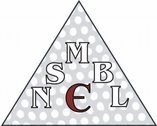
Project Partners:
1. Institute of Electronic Materials Technology (ITME), Warsaw, Poland
2. University of Zaragoza, Instituto de Ciencia de Materiales de Aragón (ICMA), Spain
3. Brunel University (BU), Kingston Lane, Uxbridge, United Kingdom
4. Consejo Superior de Investigaciones Cientificas (CSIS), Instituto de Óptica, Madrid, Spain
5. Foundation for Research and Technology Hellas (FORTH), Heraklion, Greece
6. University of Southampton (UoS), Southampton, United Kingdom
7. Leibniz-Institut für Kristallzüchtung (IKZ), Berlin, Germany
8. Research Institute for Solid State Physics and Optics (RISSPO), Budapest, Hungary

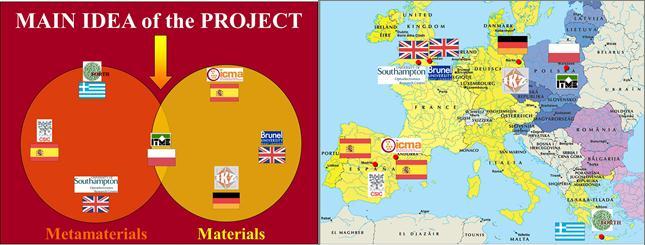
General CONCEPT: Growth of eutectics is recognized as a paradigm for pattern-forming or ‘self-organising systems’. Self-organised structures on size scales reaching down to the submicron and nanoscale regime emerge due to the interplay of chemical diffusion and capillarity. The fundamentally novel CONCEPT of the project was to utilize - for the first time - eutectic self-organisation for the preparation of multi-component and multi-scale structures with controlled physicochemical and structural properties, with geometrical motifs capable of generating novel, predictable and controllable electromagnetic functionalities. This required a deeper understanding of factors influencing eutectic self-organisation mechanisms on the submicron/nanoscale.
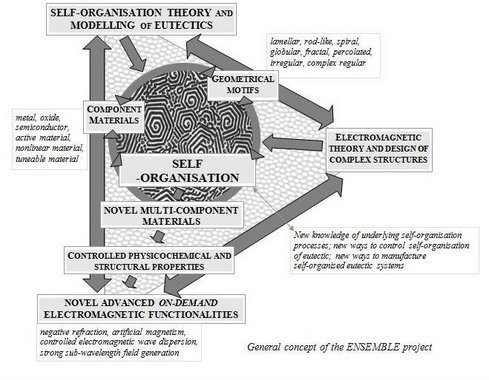
The OBJECTIVE of this project was to design, manufacture, and characterize self-organised multi-component and multi-scale structures, which display:
O1: Controlled geometrical motifs, including rod-like, lamellar, globular and percolating patterns, which can provide the expected electromagnetic functionalities;
O2: Controlled composition and physico-chemical structure, realized by combining materials with different refractive indices or different optical properties, which can provide the theoretically-predicted electromagnetic functionalities;
O3: Controllable size of structuring ranging from micro- to nano scale following the theoretical predictions;
O4: Novel predictable and controllable electromagnetic properties. At least one of the following properties can be obtained: controlled effective refractive index,; artificial magnetism; controlled dispersion; controlled sub-wavelength field generation and enhancement.
O5: Metamaterialscapabilities which extend to applications such as: imaging, high compact optoelectronic devices, efficient photovoltaics and active devices.
RESULTS: Research and industrial development depends on novel materials, on their associated novel properties and enabled by them functionalities. That is why the overall objective of ENSEMBLE project was to design, manufacture, and characterize self-organised multi-component and multi-scale structures, which display: controlled geometrical motifs, controlled composition and physico-chemical structure, controllable size of structuring ranging from micro- to nano, novel predictable and controllable electromagnetic properties and metamaterials capabilities.
In order to achieve the main objective ENSEMBLE Project developed: (i) new modelling tools in order to gain insight into eutectic self-organization and the control mechanisms behind, (ii) new modelling tools enabling design of composite materials with special electromagnetic properties as well as comparing the experimental results for obtained materials with theory, (iii) novel technologies and novel materials which were characterized by often specially designed characterization set-ups (iv), as well as finally we demonstrated new materials exhibiting special electromagnetic properties (v).
To understand the self-organization processes in eutectic growth we have developed multi-scale modeling tools. These tools all working in 3D are: (i) an atomistic phase-field theory [the phase-field crystal (PFC) approach] for unary and binary solidification; (ii) a quantitative phase-field model working on the submicron to micron scale; (iii) a quantitative phase-field model coupled with hydrodynamics (with the Navier-Stokes equation) in three dimensions relying of spectral methods combined with operator splitting; and (iv) a quantitative multi-phase-field theory working above the micron scale. 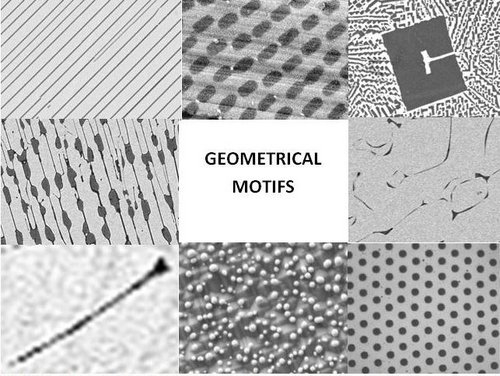
To understand the electromagnetic properties of the manufactured materials and to be able to design materials with special electromagnetic properties on-demand we generated simple models and numerical methods that allowed electromagnetic modeling and simulations of eutectic self-organised micro and nanostructures, and enabled assistance in the design and characterization. 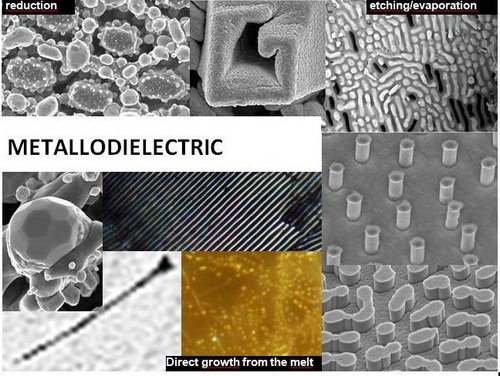
We have successfully grown self-organized materials as eutectic and eutectic-like materials with controlled geometrical motifs including rodlike, lamellar, or with such unusual geometries like eutectics with geometries resembling working metamaterial structures (split-ring-resonator and fishet-like structures). We have demonstrated control of eutectic structures, from fibrous to lamellar, according to the growth rate used. We have successfully grown materials with controlled composition and physico-chemical structure, realized by combining materials with different refractive indices or different optical properties aiming at specific electromagnetic functionalities. We have successfully obtained metallodielectric materials incorporating metals at the melt extraction step or after subsequent treatment or by producing templates for subsequent metallization. We succeeded in pushing the refinement of the structure down to the nanoscale utilizing various methodologies such as increasing the solidification rate of the materials, adding additional phase, doping with nanoparticles. By combining the controllable composition, geometrical motifs and size of structuring we demonstrated materials with predictable and controllable electromagnetic properties. 
We demonstrated the potential metamaterial-based applications of self-organized eutectics: (i) photoactive eutectics as photoanodes in photoelectrochemical cells (PECs) – experimental demonstration; (ii) bulk nanoplasmonic materials with localized surface plasmon resonance (LSPR) in visible and infrared, as well as enhanced photoluminescence due to LSPR in manufactured nanoplasmonic materials – experimental demonstration, (iv) subwavelength resolution imaging (superlensing) and subwavelength propagation and transmission in polaritonic eutectics, due to four different phenomena (all numerically demonstrated): hyperbolic dispersion relation, backward radiation in negative permittivity materials, subwavelength Mie resonances in permittivity near zero materials, surface phonon-polariton modes and gap-phonon polariton modes. |